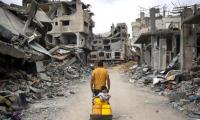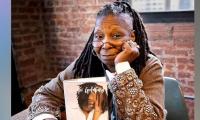The Australian High Commission in Pakistan and city-wide social cultural uplift movement I AM KARACHI have teamed together to launch a series of public art murals across the streets of Karachi, painted by Australian artist Gabrielle Brinsmead and Pakistani artist Phool Ji. The project aims to foster cultural connections between Australia and Pakistan and transform the public spaces in the city with inspiring art and positive messages.
Wall-chalking had spread like a virus and turned the walls of the once beautiful cosmopolitan city of Karachi into a myriad of political messaging and free advertising space marring the vistas. Once upon a time, wall-chalking was restricted to the walls adjacent to the railway lines leading to and out of Karachi as well as the areas pertaining to the circular railway. As a child, this scribe used to come to Karachi for vacations from PAF Public School, Sargodha, twice a year. While approaching Karachi, one could not help noticing the graffiti, some of it hilarious but mostly obnoxious. Over a period of time, the messages morphed into political ones, praising one party or besmirching another. A further degeneration was observed when ethnic and sectarian discriminatory messages became the order of the day.
The syndrome of political awareness in the multicultural metropolis permeated into the urge to spread the message beyond billboards. Social media messages had not caught on yet. This led the malady to now invade the finer senses of the residents by using the walls of busy public places like Saddar and then move on into residential districts, including the posh areas. Various city governments picked up the cudgel to ban wall-chalking and even go to the extent of imposing fines on the culprits. The Sindh home department has periodically imposed bans on wall-chalking under Section 144 CrPC. Unfortunately, these bans have been short lived and limited to periods close to national or provincial elections.Administration of the posh residential area of DHA tried to enforce a prohibition on wall-chalking and graffiti in its domain.
DHA vigilance was brought in to launch campaigns and take versatile measures to avert and remove wall chalking in Defence. It even threatened apprehending the culprits and handing them over to the local police for incarceration and imposition of penalties. The campaigns have not brought out the desired results.
When Nazims were leading the local city administration, they tried to provide special squads to all union councils to remove wall chalking and old and outdated banners and posters. The squads were tasked to ensure that no one resorted to wall-chalking. Alas the compulsive offenders continued to return to their evil practice of destroying Karachi’s beauty by running their business through wall chalking.
Good Samaritans and volunteer groups have emerged time and again, to try and stem the rot by inviting students and concerned citizens to white wash the walls but the visual pollution through unethical and disgusting advertisements keeps returning.
In this milieu, the initiative of the Australian High Commission and I AM KARACHI is a welcome step. While inaugurating the ceremony held to launch the drive, Australia’s Honorary Consul in Karachi revealed the themes of the art murals – women’s empowerment and the environment – being the key part of Australia’s work in Pakistan.
It was brought out that art plays a major role in society, and it can be an effective and inspiring way to reach people with important messages. The Honorary Consul expressed the hope that these artworks will help promote gender equality and women’s empowerment and make the society ponder on what it can do to help to protect wildlife and habitats, as well as make a positive contribution to the city of Karachi.
Having returned earlier this year from an extended stay with my elder son and his family at New South Wales in Australia, I was deeply touched by the words of Australian painter and artist, Gabrielle Brinsmead, who expressed her opinion that the climate of Karachi is similar to the climate of Northern New South Wales in Australia, where she grew up.
Gabrielle Brinsmead, who has spent the last few months in Karachi, despite the challenges of the pandemic COVID-19, while talking of her art at the launching ceremony, opined that while studying the intricacies of the flowers and leaves of bougainvillea, hibiscus and frangipani flowers, that are abound in New South Wales as well as in Karachi, she found remarkable similarities. She disclosed that she had combined shapes and colours of these flowers in the murals to draw attention to the richness and generosity of these plants, which grow and flower so effortlessly in Karachi.
The efforts of I AM KARACHI merit mention because it has joined the project of reclaiming the walls of Karachi turning them into a symbol of peace and harmony and a message of hope and positivity; since people grow strong and united through tolerance and acceptance.
Presently, the Australian High Commission has taken the initiative of reversing the ugliness of Karachi’s walls, replacing them with attractive murals. If only someone would seriously pick up the gauntlet of ridding Karachi, once the crown jewel of Pakistan, of its colossal garbage disposal issue, which is aggravating through neglect and callousness of its administrators. Politicians will keep squabbling for funds to accomplish what is in their statement of responsibilities and blame each other for criminal neglect or pass the buck.
Apparently, there is a lack of seriousness in the city administration, provincial as well as the federal government in resolving the crisis. Hopefully some humanitarian organization will make a Herculean effort to clean the Aegean’s Stables of Karachi.
Khyber Pakhtunkhwa Chief Minister Ali Amin Gandapur. —Radio PakistanISLAMABAD. All the witnesses have been...
Former prime minister, MNA Raja Pervez Ashraf speaking on the occasion of World Press Freedom Day at the National...
Poster of “7th Sky Entertainment” drama serial “Khumar”. — YouTube/Geo News KARACHI: The last episode of...
Mahr Sahibzad Khan. — PMD websiteISLAMABAD: Prime Minister Shehbaz Sharif approved the summary for re-employment of...
Pashtunkhwa Mili Awami Party Chairman Mahmood Khan Achakzai is participating in a protest in Pishin against alleged...
In this screengrab, Agriculture Minister Ashiq Hussain Kirmani chairs a meeting, Punjab Agriculture Secretary Iftikhar...







